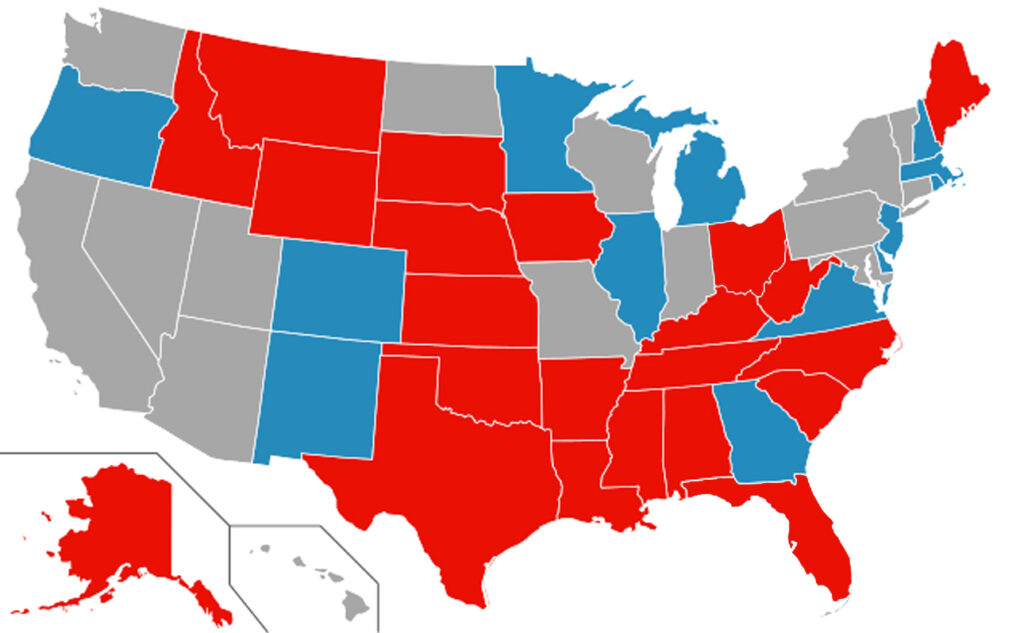[ad_1]
In this year’s Senate elections, Democrats won over 2 million more votes than Republicans but still lost their majority. So much for democracy.
The Senate is famously biased toward the GOP, and with less ticket-splitting these days, that leaves Democrats with quite the hole to climb out of.
But there is a ladder back to the majority, even if it’s a tall one.
Democrats have performed well in the past two midterm elections, riding a blue wave to a net gain of 40 House seats in 2018 and flipping one Senate seat in 2022, a midterm they were expected to lose decisively. In 2018, Democrats lost four Senate seats while gaining two, but all the losses were in red states, like North Dakota (!) and Indiana (!!).
In 2024, though, they saw their 51-seat majority slashed to 47 as the GOP claimed the chamber. But the 2026 midterms alone almost certainly won’t put them back in the Senate majority. There are only two good shots at pickups that year: Maine and North Carolina.
2026
North Carolina’s Thom Tillis, who plans to run in 2026, is the only Republican senator to occupy a seat won by less than 5 percentage points in its most recent election. In 2020, his Senate race was also a prime pickup opportunity for Democrats, only for their nominee, Cal Cunningham, to get dragged down by an extramarital relationship that featured such scandalous texts as “Would make my day to roll over and kiss you about now.” Hurting Cunningham all the more was a higher-than-expected Republican turnout.
So far, in North Carolina, only Democratic Rep. Wiley Nickel has filed paperwork to run. Nickel won a surprise victory in 2022, but he’s exiting the House in January because state Republicans gerrymandered his district to death. And if outgoing Democratic Gov. Roy Cooper tosses his hat into the ring, as is rumored—well, that could be lights out for Tills. Cooper is undefeated across six consecutive statewide races, from the attorney general’s race in 2000 through the governor’s race in 2020.
Up in Maine is perennially “concerned” Republican moderate Susan Collins, who plans to run again. (If reelected, she would be 79 at the end of her next term.) In 2020, Collins beat Democrat Sara Gideon in something of an upset given that Gideon had consistently led in the polls. But Mainers split the heck out of their vote that year: Collins won by 8.6 points, while Joe Biden won the state by 9.1 points.

But ticket-splitting is becoming less common, and Collins and Tillis will have to navigate two years of Donald Trump 2.0. That’ll likely include having to take risky votes on batshit Cabinet nominees, potentially economy-wrecking tariffs, and closing the Department of Education—to say nothing of the scandals that will surely consume Trump’s incoming administration. Even Trump’s other plans are likely to become toxic for Republican lawmakers. For example, mass deportations will largely be run by the “father” of family separation—a Trump 1.0 policy so morally obscene and politically toxic that the Donald bent to public pressure and killed it.
But flipping these two seats in 2026 would still leave Democrats in the minority. So now we turn to 2028, which has two more pickup opportunities: Wisconsin and North Carolina (again).
2028
North Carolina Sen. Ted Budd, a freshman Republican, performed better in his most recent election (2022) than Tillis did in his (2020), winning by 3.2 points, though Budd undershot his polls by about 1 point. Still, he’s been a fairly anonymous senator, which might make it hard for Democrats to paint him as an extremist … unlike Wisconsin’s Ron Johnson.
Johnson is a prominent election denier, skeptic of COVID-19 vaccines, and conspiracy theorist. The editorial board of the largest newspaper in his state argued he should be expelled from Congress after the Jan. 6, 2021, attack on the U.S. Capitol. Two months later, Johnson said Jan. 6 rioters “love this country” but that he’d have felt “concerned” if the attackers had been part of Black Lives Matter.
Johnson won his 2022 reelection by 1 point, underperforming his polls by over 2 points. While he hasn’t stated whether he’ll run in 2028, his presence on the ballot would boost Democrats’ chances of flipping the seat. (If reelected, he would be nearly 79 by the end of his next term.)
On defense
Between 2026 and 2028, though, Democrats must also defend six seats that were decided by fewer than 5 points the most recent time the seat was up. Two of the hardest to defend—Georgia’s Jon Ossoff and Michigan’s Gary Peters—will come in 2026, which should be a favorable midterm for them.
The other four potential Republican flips come in 2028, when Nevada’s Catherine Cortez Masto is likely to face a hard fight. In 2022, she won reelection by less than 1 point. And it’s hard to predict what kind of political environment we’ll find ourselves in then. After all, it’ll be a presidential election year.

Nevertheless, holding all their seats and flipping four across these two elections would put Democrats back into the majority. But flip the White House in 2028 and they need only three.
Republished with permission from Daily Kos.
[ad_2]
Source link

